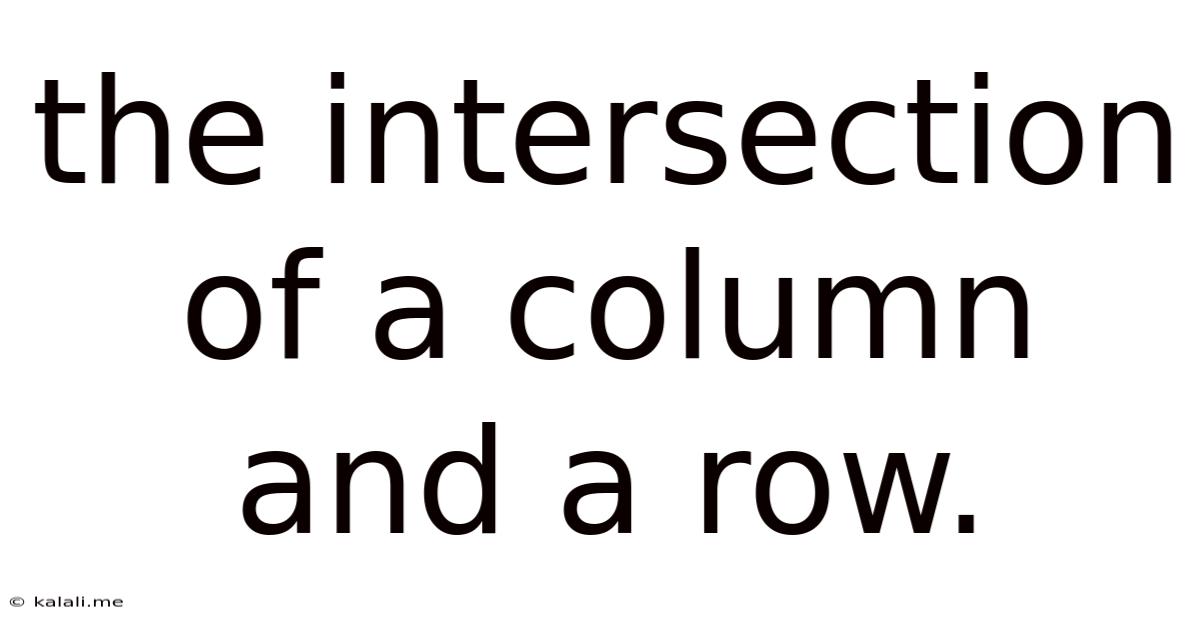The Intersection Of A Column And A Row.
Kalali
Jun 11, 2025 · 3 min read

Table of Contents
The Intersection of a Column and a Row: Understanding Cells and Their Significance
The seemingly simple intersection of a column and a row holds immense significance across various fields, from spreadsheet software like Microsoft Excel and Google Sheets to database management and even mathematical matrices. This intersection, often referred to as a cell, forms the fundamental building block of organized data presentation and manipulation. This article will delve into the concept of this intersection, exploring its role in different contexts and highlighting its importance in data organization and analysis.
What is a Cell? A Deep Dive into the Intersection
In the simplest terms, a cell is the point where a single column and a single row meet. Imagine a grid; the vertical lines are columns, the horizontal lines are rows, and the space where they cross is a cell. Each cell is uniquely identifiable by its column and row coordinates, allowing for precise data location and retrieval. For example, in a spreadsheet, a cell might be referenced as "A1," indicating the intersection of column A and row 1. This precise referencing system is critical for managing and manipulating data efficiently.
The Significance of Cell Intersections Across Disciplines
The concept of the intersection of a column and a row isn't limited to spreadsheets. Its importance spans various domains:
1. Spreadsheet Software: This is where the concept is most visibly utilized. Spreadsheets rely on the cell structure to organize numerical data, text, formulas, and more. Each cell can contain a single piece of information, and the arrangement of these cells allows for complex calculations, data visualization, and reporting.
2. Database Management: Relational databases also use a similar structure. Tables in databases are essentially two-dimensional arrays where columns represent attributes (like "Name" or "Age") and rows represent individual records. The intersection of a column and row represents a specific attribute value for a particular record.
3. Matrices in Mathematics: In linear algebra, matrices are rectangular arrays of numbers. Each entry within the matrix is located at the intersection of a row and a column, just like in a spreadsheet. These intersections are crucial for matrix operations like addition, multiplication, and finding determinants.
Beyond the Basics: Advanced Concepts and Applications
The seemingly basic concept of the cell intersection becomes increasingly complex when considering advanced functionalities:
- Cell Formatting: Control over font styles, number formats, cell borders, and colors is applied to individual cells, enhancing data presentation and readability.
- Formulas and Functions: Cells can contain formulas that perform calculations based on data in other cells, allowing for automated data processing and analysis. This is a core strength of spreadsheet software.
- Data Validation: Rules can be applied to cells to ensure data integrity, preventing errors and inconsistencies.
- Data Filtering and Sorting: Cells allow for efficient sorting and filtering of data based on criteria applied to specific columns or rows.
- Data Aggregation: Functions like SUM, AVERAGE, and COUNT are applied to ranges of cells to summarize data effectively.
Conclusion: The Unsung Hero of Data Organization
The seemingly simple intersection of a column and a row—the humble cell—is a cornerstone of data organization and manipulation. From the simplest spreadsheet to complex databases and mathematical matrices, understanding this fundamental concept is key to unlocking the power of structured data. The ability to precisely locate, access, and manipulate data within these cells is crucial for efficient data analysis, reporting, and decision-making across various fields. Mastering this foundational concept provides a solid base for anyone working with data.
Latest Posts
Latest Posts
-
How Many Grams Is In A Pint
Jul 01, 2025
-
Lyrics To The Song Stand By Donnie Mcclurkin
Jul 01, 2025
-
How Much Is 3 Quarts Of Water
Jul 01, 2025
-
How Many Cups Is 1 Pound Of Pasta
Jul 01, 2025
-
Or Or Or Or Or Or Or Or Or
Jul 01, 2025
Related Post
Thank you for visiting our website which covers about The Intersection Of A Column And A Row. . We hope the information provided has been useful to you. Feel free to contact us if you have any questions or need further assistance. See you next time and don't miss to bookmark.